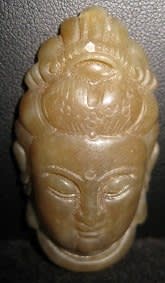Jade Head of Guanyin, 19th Century CE
1.8
LR.027
Noted for her kindness, Guanyin is an ancient Boddhisattva. In Buddhism, Boddhisattvas are beings who have attained enlightenment, but renounce the goal of Nirvana, a state characterized by freedom from...
Noted for her kindness, Guanyin is an ancient Boddhisattva. In Buddhism, Boddhisattvas are beings who have attained enlightenment, but renounce the goal of Nirvana, a state characterized by freedom from pain, suffering and the external world. Instead, these benevolent Boddhisattvas minister eternally to relieve the sufferings of all creatures, like Archangels, passing from the remote heaven to the world of men. As such, the Guanyin makes helping others toward enlightenment her mission. Originally depicted as a male in early Chinese Buddhist forms, the Guanyin eventually became associated with a local Chinese Mother Goddess, "bringer of children," and also because the gentleness and compassion of the deity suggest feminine qualities.
This this graceful and serene jade sculpture depicts Guanyin, one of the most popular of all bodhisattvas, whose name literally means 'the one who always hears sounds'. Known in China as 'the compassionate Bodhisattva', who listens to every prayer, Guanyin was often placed behind the main Buddha image in a temple or flanking a figure of the Buddha himself. However, as this jade sculpture is just a bust, we may inquire about its origins and function.
The ability to render such a sophisticated design in jade demonstrates the technological prowess of the Qing dynasty. Rendering the free-flowing, curling headdress-cum-crown would have required a tremendous amount of skill, not to mention achieving the softness of the facial features that live up to the Guanyin’s status in the Buddhist pantheon as the deity of mercy. Beneath the stunning hair, a finely impressed urna is placed in the middle of the full forehead directly between the two eyebrows. Through the bodhisattva’s incised eyebrows that slope in parallel with her eyes, we gain a sense of character and demeanour from the bodhisattva. Low-hanging earlobes – a symbol of divinity and the renunciation of worldly desires – further demonstrate devotion as well as artistic accomplishment. In all, a softening of features achieved by the smoothness and plumpness of the jade medium render this bust a magnificent example of Guanyin’s compassion.
This this graceful and serene jade sculpture depicts Guanyin, one of the most popular of all bodhisattvas, whose name literally means 'the one who always hears sounds'. Known in China as 'the compassionate Bodhisattva', who listens to every prayer, Guanyin was often placed behind the main Buddha image in a temple or flanking a figure of the Buddha himself. However, as this jade sculpture is just a bust, we may inquire about its origins and function.
The ability to render such a sophisticated design in jade demonstrates the technological prowess of the Qing dynasty. Rendering the free-flowing, curling headdress-cum-crown would have required a tremendous amount of skill, not to mention achieving the softness of the facial features that live up to the Guanyin’s status in the Buddhist pantheon as the deity of mercy. Beneath the stunning hair, a finely impressed urna is placed in the middle of the full forehead directly between the two eyebrows. Through the bodhisattva’s incised eyebrows that slope in parallel with her eyes, we gain a sense of character and demeanour from the bodhisattva. Low-hanging earlobes – a symbol of divinity and the renunciation of worldly desires – further demonstrate devotion as well as artistic accomplishment. In all, a softening of features achieved by the smoothness and plumpness of the jade medium render this bust a magnificent example of Guanyin’s compassion.
